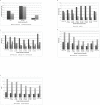Dyschloremia Is a Risk Factor for the Development of Acute Kidney Injury in Critically Ill Patients
- PMID: 27490461
- PMCID: PMC4974002
- DOI: 10.1371/journal.pone.0160322
Dyschloremia Is a Risk Factor for the Development of Acute Kidney Injury in Critically Ill Patients
Abstract
Introduction: Dyschloremia is common in critically ill patients, although its impact has not been well studied. We investigated the epidemiology of dyschloremia and its associations with the incidence of acute kidney injury and other intensive care unit outcomes.
Material and methods: This is a single-center, retrospective cohort study at Mayo Clinic Hospital-Rochester. All adult patients admitted to intensive care units from January 1st, 2006, through December 30th, 2012 were included. Patients with known acute kidney injury and chronic kidney disease stage 5 before intensive care unit admission were excluded. We evaluated the association of dyschloremia with ICU outcomes, after adjustments for the effect of age, gender, Charlson comorbidity index and severity of illness score.
Results: A total of 6,025 patients were enrolled in the final analysis following the implementation of eligibility criteria. From the cohort, 1,970 patients (33%) developed acute kidney injury. Of the total patients enrolled, 4,174 had a baseline serum chloride. In this group, 1,530 (37%) had hypochloremia, and 257 (6%) were hyperchloremic. The incidence of acute kidney injury was higher in hypochloremic and hyperchloremic patients compared to those with a normal serum chloride level (43% vs.30% and 34% vs. 30%, respectively; P < .001). Baseline serum chloride was lower in the acute kidney injury group vs. the non-acute kidney injury group [100 mmol/L (96-104) vs. 102 mmol/L (98-105), P < .0001]. In a multivariable logistic regression model, baseline serum chloride of ≤94 mmol/L found to be independently associated with the risk of acute kidney injury (OR 1.7, 95% CI 1.1-2.6; P = .01).
Discussion: Dyschloremia is common in critically ill patients, and severe hypochloremia is independently associated with an increased risk of development of acute kidney injury.
Conflict of interest statement
Figures


Similar articles
-
Dyschloremia is associated with failure to restore renal function in survivors with acute kidney injury: an observation retrospective study.Sci Rep. 2020 Nov 12;10(1):19623. doi: 10.1038/s41598-020-76798-5. Sci Rep. 2020. PMID: 33184400 Free PMC article.
-
Effect of hyperchloremia on acute kidney injury in critically ill septic patients: a retrospective cohort study.BMC Nephrol. 2017 Dec 2;18(1):346. doi: 10.1186/s12882-017-0750-z. BMC Nephrol. 2017. PMID: 29197350 Free PMC article.
-
The association of acute kidney injury in the critically ill and postdischarge outcomes: a cohort study*.Crit Care Med. 2015 Feb;43(2):354-64. doi: 10.1097/CCM.0000000000000706. Crit Care Med. 2015. PMID: 25474534
-
Chloride in intensive care units: a key electrolyte.F1000Res. 2017 Nov 1;6:1930. doi: 10.12688/f1000research.11401.1. eCollection 2017. F1000Res. 2017. PMID: 29123653 Free PMC article. Review.
-
Epidemiology and Pathogenesis of Acute Kidney Injury in the Critically Ill Patients.Indian J Crit Care Med. 2020 Apr;24(Suppl 3):S84-S89. doi: 10.5005/jp-journals-10071-23394. Indian J Crit Care Med. 2020. PMID: 32704209 Free PMC article. Review.
Cited by
-
Is dyschloremia a marker of critical illness or euchloremia an interventional target to improve outcomes?Ann Transl Med. 2019 Dec;7(Suppl 8):S264. doi: 10.21037/atm.2019.12.48. Ann Transl Med. 2019. PMID: 32015983 Free PMC article. No abstract available.
-
Association between serum chloride levels with mortality in critically ill patients with acute kidney injury: An observational multicenter study employing the eICU database.PLoS One. 2022 Aug 23;17(8):e0273283. doi: 10.1371/journal.pone.0273283. eCollection 2022. PLoS One. 2022. PMID: 35998143 Free PMC article.
-
Dyschloremia is associated with failure to restore renal function in survivors with acute kidney injury: an observation retrospective study.Sci Rep. 2020 Nov 12;10(1):19623. doi: 10.1038/s41598-020-76798-5. Sci Rep. 2020. PMID: 33184400 Free PMC article.
-
Which risk predictors are more likely to indicate severe AKI in hospitalized patients?Int J Med Inform. 2020 Nov;143:104270. doi: 10.1016/j.ijmedinf.2020.104270. Epub 2020 Sep 11. Int J Med Inform. 2020. PMID: 32961504 Free PMC article.
-
Feature Ranking in Predictive Models for Hospital-Acquired Acute Kidney Injury.Sci Rep. 2018 Nov 23;8(1):17298. doi: 10.1038/s41598-018-35487-0. Sci Rep. 2018. PMID: 30470779 Free PMC article.
References
Publication types
MeSH terms
Substances
LinkOut - more resources
Full Text Sources
Other Literature Sources

